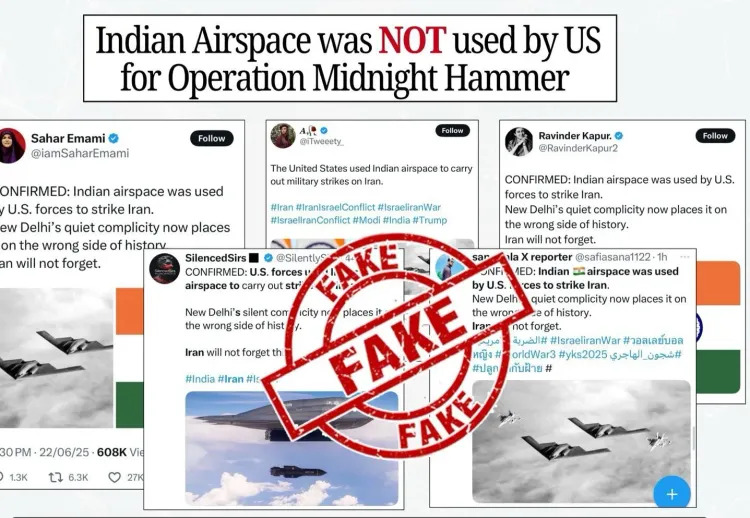Did the US Really Use Indian Airspace to Strike Iran?

Synopsis
Key Takeaways
- Indian airspace was not used in US military operations against Iran.
- Operation Midnight Hammer targeted key nuclear facilities in Iran.
- US military strikes were confirmed by Defence Secretary Pete Hegseth.
- President Trump described the operation as a significant military achievement.
- The US is open to diplomacy with Iran while preparing for potential retaliation.
New Delhi, June 22 (NationPress) The Indian government has officially refuted claims circulating on social media that the United States utilized Indian airspace to launch military aircraft against Iran during Operation Midnight Hammer.
Earlier, US Defence Secretary Pete Hegseth stated that American military operations had significantly impaired Iran's nuclear capabilities, while Vice President J.D. Vance suggested that the US remains open to diplomatic negotiations with Tehran.
The Press Information Bureau (PIB) took to X to clarify: "Numerous social media profiles are alleging that Indian airspace was exploited by the United States for launching aircraft against Iran during Operation Midnight Hammer. This assertion is false. Indian airspace was not utilized by the United States during this operation."
According to the PIB, during a briefing, Joint Chiefs of Staff Chair Gen. Dan Caine outlined the flight paths taken by the US aircraft.
In a Pentagon press briefing, Hegseth claimed: "We have severely impacted the Iranian nuclear program." He confirmed that the operation was carried out under the direct orders of US President Donald Trump and involved careful planning and execution.
"The directive we received from our Commander-in-Chief was focused, powerful, and unmistakable," Hegseth remarked.
The military initiative, known as Operation Midnight Hammer, was aimed at Iran's key nuclear enrichment facilities located at Natanz, Isfahan, and Fordow.
The coordinated assault involved over 125 military aircraft, including B-2 stealth bombers, and the deployment of 14 GBU-57 bunker-buster bombs, along with more than 30 Tomahawk missiles.
Previously, President Trump characterized the strike on Iranian facilities as a "spectacular military success."
He stated, "A short while ago, the US military executed massive precision strikes on three critical nuclear facilities in the Iranian regime. Our aim was to dismantle Iran's nuclear enrichment capabilities and curb the nuclear threat posed by the world's leading state sponsor of terror. Tonight, I can assure the world that these strikes were a remarkable military achievement," Trump stated during his address.
Vice President J.D. Vance mentioned that the US still wishes to engage in diplomacy with Iran but is prepared for any potential scenarios.
"We're ready in case the Iranians retaliate, but... if they choose to escalate by attacking American forces, that would be a grave error," he expressed in an interview.
Hegseth cautioned that any Iranian retaliation would provoke a stronger response from the US.
"This is not the previous administration. President Trump has made it clear: no nuclear weapons. He seeks peace, and Iran should follow that path. He issued a statement last night emphasizing this. Any retaliation by Iran against the United States will be met with an overwhelming force far beyond what was witnessed tonight," he asserted.






